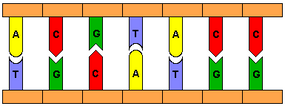DNA
You have probably heard of the DNA molecule referred to as the "double-helix." DNA is like two strings twisted together in a long spiral.
DNA is found in all cells as base pairs made of four different nucleotides. Each base pair is formed from two complementary nucleotides bonded together. The four bases in DNA's alphabet are:
Advertisement
- Adenine
- Cytosine
- Guanine
- Thymine
Adenine and thymine always bond together as a pair, and cytosine and guanine bond together as a pair. The pairs link together like rungs in a ladder:

In an E. coli bacterium, this ladder is about 4 million base pairs long. The two ends link together to form a ring, and then the ring gets wadded up to fit inside the cell. The entire ring is known as the genome, and scientists have completely decoded it. That is, scientists know all 4 million of the base pairs needed to form an E. coli bacterium's DNA exactly. The human genome project is in the process of finding all 3 billion or so of the base pairs in a typical human's DNA.
